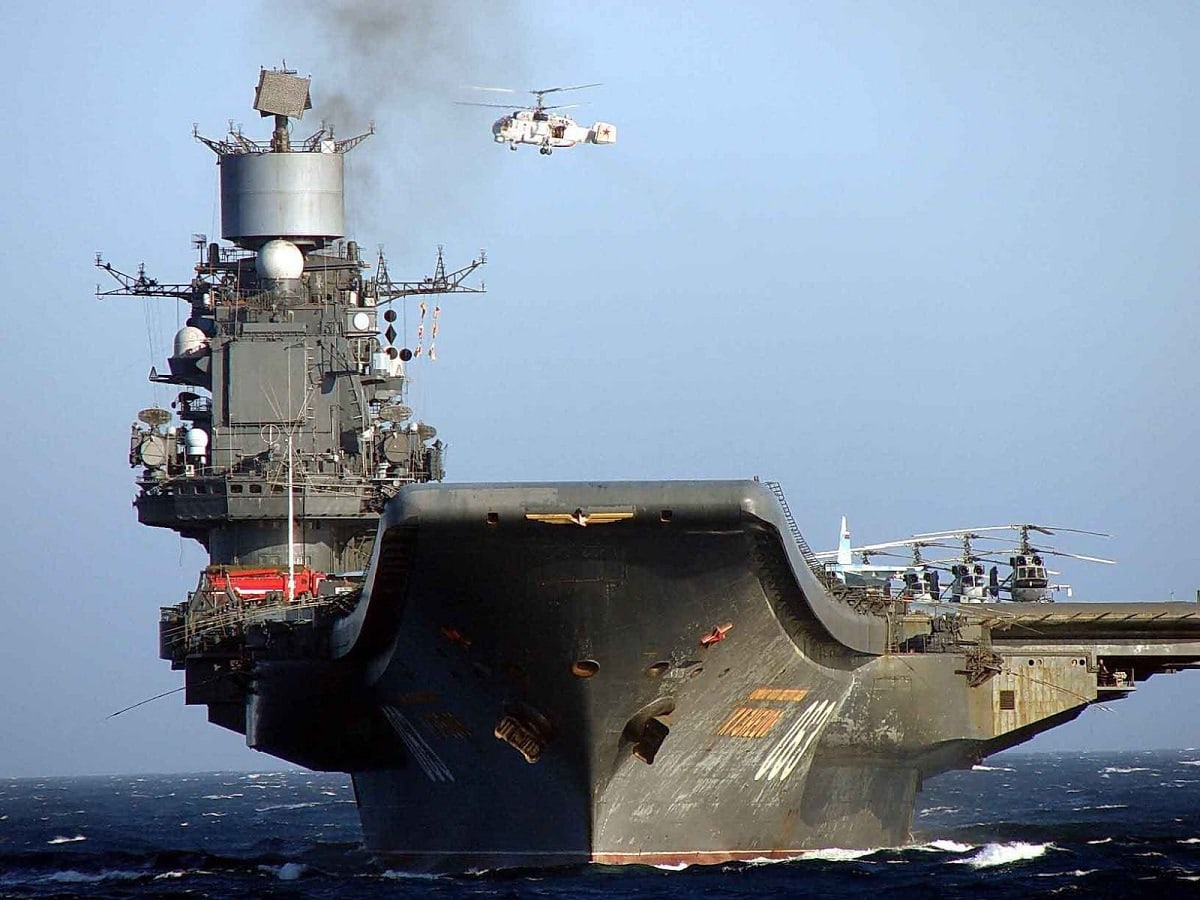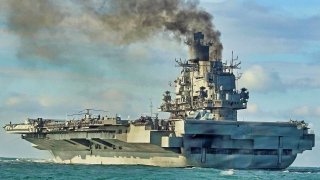Russia's 'Aircraft Carrier' Crisis Looks Impossible to Solve
As the U.S. Navy prepares to commission its second Gerald R. Ford-class aircraft carrier, Russia remains reliant on its lone, beleaguered Admiral Kuznetsov for sea-based power projection.
Summary and Key Points: As the U.S. Navy prepares to commission its second Gerald R. Ford-class aircraft carrier, Russia remains reliant on its lone, beleaguered Admiral Kuznetsov for sea-based power projection.

-While once a symbol of Soviet naval ambition, the Kuznetsov has been plagued by numerous failures, including fires, faulty equipment, and limited operational capability.
-In contrast, the U.S. continues to advance its naval power with state-of-the-art carriers. Despite attempts to modernize, Russia's carrier program remains a far cry from its Western counterparts, highlighting a significant gap in naval capabilities that leaves Russia struggling to keep pace in the 21st century.
Admiral Kuznetsov: Russia’s Troubled Carrier Amid U.S. Naval Dominance
As Russia inches closer to commissioning its second Gerald R. Ford-class carrier, the gap in capabilities between Russian and Western naval power remains stark.
While the U.S. Navy is inching closer to commissioning its second Gerald R. Ford-class aircraft carrier, Russia remains dependent on its semi-defunct Admiral Kuznetsov for sea-based power projection. Despite the former Soviet Union’s military prowess and development during the Cold War, the completion of robust aircraft carriers never came to fruition. Once the USSR collapsed in 1991, any hopes for the Soviet’s carrier aspirations came crumbling down. Due to poor planning and timing over the years, Russia possesses a singular aircraft carrier in its naval fleet. To make matters worse, Admiral Kuznetsov has proven to be a massive disappointment.
The History of Russia’s Navy:
Following the death of Peter the Great in the early 18th century, the Imperial Russian Navy sharply declined. In fact, between 1726-1730, only 54 ships were constructed. During the second half of this century, Russia saw an uptick in its naval development due to its domination of the Black Sea. By the turn of the 19th century, Russia’s progress on this front ramped up quickly. The Russian Navy became the second most powerful naval force across the globe at this time, second to the United Kingdom.
However, the naval might Russia possessed was soon nixed following the Russo-Japanese War, which resulted in a tremendous loss of Russian ships. To rectify this downfall, Tsar Nicholas II launched a hefty shipbuilding development program, which granted Russia a larger sea-based fleet than its Central Power enemies when the First World War broke out.
The trajectory of the Russian Navy would remain tumultuous for years to come. During the Russian Civil War, which would ultimately lead to the rise of the new Soviet Union, Russia’s naval fleet was completely weakened as a fighting force. With the Bolsheviks in charge, a renewed interest in building up the naval fleet was prioritized.
Although the USSR worked hard to quickly develop advanced battleships, destroyers, and cruisers around the WWI era, the U.S., Japan, and Great Britain pivoted toward adopted aircraft carriers. In a sense, the Soviets missed the boat on taking advantage of these years to build up their career potential.
The rise of the Kuznetsov-class aircraft carrier
It wasn’t until the late 1930’s that aircraft carriers would be prioritized by the Soviets in one of Stalin’s five-year plans.
The “Project 71” class, however, was largely put on hold when the Second World War broke out. Over the next few decades, additional carrier class prototypes were introduced, yet they never came to fruition due to frequent changes in the country’s political leadership. By the mid-1980s, the push to develop a homegrown aircraft carrier was finally fruitful.
Admiral Flota Sovetskoho Soyuza Kuznetsov was constructed at Chernomorskiy Shipyard and officially launched by the middle of the decade. Initially, the ship was named Riga before being redesignated as Leonid Brezhnev, Tbilisi, and finally Kuznetsov over the years.

Kuznetsov was designed to be the lead ship of the Admiral Kuznetsov-class of aircraft carriers. However, when the USSR collapsed, Kuznetsov’s sister ship- Varyag- was not complete. The Kuznetsov became the sole carrier to sail for the new Russian Federation in 1991, serving as the flagship of its navy. In addition to helicopters, the Kuznetsov can carry an array of Sukhoi Su-33 and MiG-29 fighters. The carrier has a complement of a dozen long-range surface-to-surface anti-ship P-700 Granit cruise missiles, giving it its “heavy aircraft-carrying missile cruise” designation.
On paper, Kuznetsov displaces roughly 60,000 tons and can sail at speeds in excess of 30 knots. The carrier is also fitted with anti-submarine warfare capabilities. As detailed by Naval Technology, “The ship is equipped with an Udav-1 anti-submarine system with 60 anti-submarine rockets. Udav-1, supplied by the Splav Research and Production Association in Moscow, protects surface ships by diverting and destroying incoming torpedoes. The system also provides defence against submarines and saboteur systems, such as underwater vehicles. The system has ten barrels and is capable of firing 111SG depth charge projectiles, 111SZ mine-laying projectiles and 111SO diverting projectiles. The range of the system is up to 3,000m and the submarine engagement depth is to 600m.”
Despite these abilities, Kuznetsov has suffered from a litany of failures and mishaps over the years. In fact, Russia’s sole carrier has remained dry-docked for the better part of the last decade. During the carrier’s first-ever deployment to aid the government-backed forces in the Syrian Civil War in 2016, two aircraft were lost, partaking in carrier operations. Faulty arresting wires were reportedly to blame for losing one Su-33 and one MiG-29K.
Following these mishaps, Kuznetsov was rendered useless as the carrier ceased launching and landing airframes. In addition to this tragic deployment, Kuznetsov has suffered from many incidents onboard, including fires, falling cranes and deck holes.
Even if Kuznetsov sets sail again as the flagship of Russia’s Navy, the carrier is limited in its capabilities when compared to its foreign counterparts.
About the Author: Maya Carlin
Maya Carlin, National Security Writer with The National Interest, is an analyst with the Center for Security Policy and a former Anna Sobol Levy Fellow at IDC Herzliya in Israel. She has by-lines in many publications, including The National Interest, Jerusalem Post, and Times of Israel. You can follow her on Twitter: @MayaCarlin.
All images are Creative Commons and/or Shutterstock.


